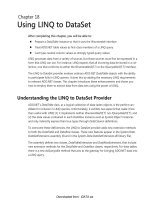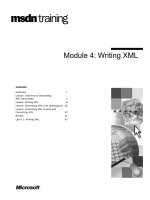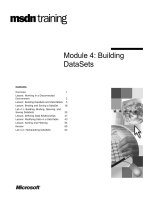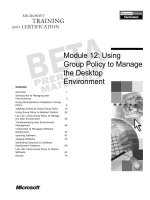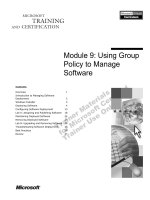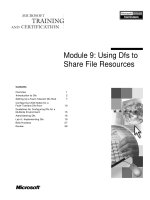Module 4: Using ADO to Access XML Data
Bạn đang xem bản rút gọn của tài liệu. Xem và tải ngay bản đầy đủ của tài liệu tại đây (916.21 KB, 38 trang )
Contents
Overview 1
Retrieving XML Data with ADO 2
Lab 4.1: Creating an ADO Client
Application 16
Using ADO and XML on an ASP-Based
Web Site 22
Lab 4.2: Using ADO on a Web Site 27
Best Practices 31
Review 32
Module 4: Using ADO to
Access XML Data
Information in this document is subject to change without notice. The names of companies,
products, people, characters, and/or data mentioned herein are fictitious and are in no way intended
to represent any real individual, company, product, or event, unless otherwise noted. Complying
with all applicable copyright laws is the responsibility of the user. No part of this document may
be reproduced or transmitted in any form or by any means, electronic or mechanical, for any
purpose, without the express written permission of Microsoft Corporation. If, however, your only
means of access is electronic, permission to print one copy is hereby granted.
Microsoft may have patents, patent applications, trademarks, copyrights, or other intellectual
property rights covering subject matter in this document. Except as expressly provided in any
written license agreement from Microsoft, the furnishing of this document does not give you any
license to these patents, trademarks, copyrights, or other intellectual property.
2001 Microsoft Corporation. All rights reserved.
Microsoft, ActiveX, BackOffice, BizTalk, MSDN, MS-DOS, SQL Server, Visual Basic, Visual
C++, Visual InterDev, Visual J++, Visual Studio, Windows, Windows Media, Windows NT, and
Windows 2000 are either registered trademarks or trademarks of Microsoft Corporation in the
U.S.A. and/or other countries.
Other product and company names mentioned herein may be the trademarks of their respective
owners.
Module 4: Using ADO to Access XML Data iii
Instructor Notes
This module provides students with the information required to retrieve
Extensible Markup Language (XML) data from Microsoft
®
SQL Server
™
by
using Microsoft ActiveX
®
Data Objects (ADO).
After completing this module, students will be able to:
Construct an XML query template.
Use a Command object and Stream objects to submit an XML query.
Apply a style sheet to the results of an XML query that uses ADO.
Return an XML query result to the Active Server Pages (ASP) Response
object.
Specify the output encoding of an XML query result.
Materials and Preparation
This section provides the materials and preparation tasks that you need to teach
this module.
Required Materials
To teach this module, you need Microsoft PowerPoint
®
file 2091a_04.ppt.
Preparation Tasks
To prepare for this module, you should:
Read all of the materials for this module.
Complete the labs.
Instructor Setup for a Lab
This section provides setup instructions that are required to prepare the
instructor computer or classroom configuration for a lab.
Lab 4.1: Creating an ADO Client Application
To prepare for the lab
• Ensure that the students perform the setup procedure on the introductory
page of the lab.
Presentation:
60 Minutes
Lab:
30 Minutes
iv Module 4: Using ADO to Access XML Data
Module Strategy
Use the following strategies to present this module:
Retrieving XML Data with ADO
Emphasize that the ability to save recordsets as XML is not specific to SQL
Server—this approach can be used with any OLE DB provider to generate
XML data from any source (for example, Microsoft Access or Microsoft
Active Directory). However, if you want to be able to take advantage of
native support for XML in SQL Server, you must use the SQL Server OLE
DB Provider (SQLOLEDB Provider).
Use the slide “Submitting an XML Query with ADO” as a high-level
introduction to the process. Then cover each step in detail on the appropriate
slide.
Using ADO and XML on an ASP-Based Web Site
Discourage students from writing ADO code directly in an ASP page.
Emphasize that components are a much more scalable and flexible solution.
When building a Web site with ADO and XML, the most important
property is the XSL property. Emphasize that you can use the XSL property
to transform the retrieved XML into Hypertext Markup Language (HTML),
Wireless Markup Language (WML), or any other presentation format
required.
The use of the SS Stream Flags property is relatively specialized. Explain
that you can use this property as a way to limit access to files in client
applications where the user can specify the location of the style sheet to be
used. Because this is not a common scenario, students will rarely use this
property with ADO.
Emphasize that XML data islands can only be used with XML-aware
browsers such as Microsoft Internet Explorer.
Module 4: Using ADO to Access XML Data 1
Overview
Retrieving XML Data with ADO
Using ADO and XML on an ASP-Based Web Site
*****************************
ILLEGAL FOR NON
-
TRAINER USE
******************************
After completing this module, you will be able to:
Construct an Extensible Markup Language (XML) query template.
Use a Command object and Stream objects to submit an XML query.
Apply a style sheet to the results of an XML query that uses Microsoft
®
ActiveX
®
Data Objects (ADO).
Return an XML query result to the Active Server Page (ASP) Response
object.
Specify the Output Encoding property of an XML query result.
Topic Objective
To provide an overview of
the module topics and
objectives.
Lead-in
In this module, you will learn
how ADO can be used to
retrieve XML data from
Microsoft SQL Server.
2 Module 4: Using ADO to Access XML Data
Retrieving XML Data with ADO
Using ADO to Retrieve XML
ADO Support for XML
Persisting ADO Recordsets as XML
Submitting an XML Query with ADO
Using a Command Object
Building XML Query Templates for ADO Commands
Assigning a Query to a Command Object
Creating a Result Stream
Executing a Query
*****************************
ILLEGAL FOR NON
-
TRAINER USE
******************************
Mostdevelopers working with the Microsoft Windows
®
operating system use
ADO as the preferred data access technology for multiple diverse data sources.
If you have already created a recordset, you can use ADO to transform it into
XML. Alternatively, you can use Microsoft SQL Server
™
to generate the XML,
and then use ADO to enter queries and retrieve results.
The ADO 2.6 library supplied with SQL Server 2000 provides the Connection,
Command, Recordset, Record, and Stream objects, and enables access to
many different data sources by using OLE DB providers.
ADO provides native support for XML so that you can persist recordsets in
XML format. You can also use the XML-related functionality of SQL Server
with ADO when you use the SQL OLE DBProvider (SQLOLEDB).
This section discusses the use of ADO to transform recordsets into XML and
retrieve data in XML format, and also describes the XML-related properties of
the SQLOLEDB Provider.
Topic Objective
To introduce the topics in
this section.
Lead-in
ADO is the preferred data
access technology for many
developers.
Module 4: Using ADO to Access XML Data 3
Using ADO to Retrieve Data
ADO
ASP Web site
ADO
Internal
Application
Customer
*****************************
ILLEGAL FOR NON
-
TRAINER USE
******************************
ADO is the standard data access API for Windows development. Most
developers are familiar with the objects in the ADO object model.
Using ADO to Access XML on a Web Site
When you are developing an ASP-based Web application that needs to access
XML data from SQL Server, consider using ADO. ADO 2.6 provides extensive
support for accessing XML data, especially when used with the SQLOLEDB
Provider. It can be more efficient to retrieve XML and transform it into
Hypertext Markup Language (HTML) format by using a style sheet than to
retrieve data as a recordset and iterate through the data in order to render it as
HTML.
Using ADO to Access XML in a Line-of-Business
Application
ADO is often used for data access in internal applications and COM
components. If you use XML in a line-of-business (LOB) application, you can
retrieve it from SQL Server by using ADO.
Topic Objective
To describe scenarios
where ADO can be used to
retrieve XML data.
Lead-in
ADO is the standard data
access API for Windows.
Delivery Tip
This slide builds
automatically to show XML
data being retrieved from an
ASP Web site, and XML
data being retrieved by a
line-of-business application.
To restart the build, press
the LEFT ARROW key on
the keyboard.
4 Module 4: Using ADO to Access XML Data
ADO Support for XML
Saving Recordsets as XML
Support for Executable Streams
SQLOLEDB Provider XML-Related Properties
*****************************
ILLEGAL FOR NON
-
TRAINER USE
******************************
The ADO library provides extensive support for XML. You can retrieve data
from any data source into a recordset, and then persist the recordset as XML.
Extensions to the SQLOLE DB Provider make it possible to retrieve XML data
from SQL Server by using the FOR XML syntax.
Saving Recordsets as XML
An ADO recordset provides a programmable object that represents a specific
set of data. You can open recordsets from any OLE DB data source or create
them dynamically, and then persist them as XML. Consider the following
advantages of saving recordsets as XML:
You can represent data from any data source by using XML.
You can open XML recordsets that you have persisted, and process them by
using any ADO-enabled or XML-enabled application.
Topic Objective
To describe the XML
support in ADO 2.6.
Lead-in
The ADO library provides
extensive support for XML.
Module 4: Using ADO to Access XML Data 5
Support for Executable Streams
The ADO library provides Stream objects to allow ADO to transfer and
manipulate stream data, such as the contents of a file. Additionally, you can use
ADO to write a query into a Stream object and execute it by using a
Command object. This is a particularly useful way of executing XML queries
that are defined in a text file.
Streams are an efficient way to process large quantities of text data such
as XML documents. An application can begin processing data read from a
stream, even if the whole stream has not yet been read. Consequently, less
memory needs to be set aside for the data in the stream.
SQLOLEDB XML-Related Properties
SQLOLEDB, the SQL Server native OLE DB provider, exposes a number of
XML-related properties that you can use when executing XML queries. These
properties enable you to apply style sheets to XML results, and to specify a
different character encoding and other options.
Provider-specific properties are accessed through the Properties collection of
ADO objects.
Note
6 Module 4: Using ADO to Access XML Data
Persisting ADO Recordsets as XML
Persisting a Recordset in a Generic XML Format
<xml xmlns:s='uuid:BDC6E3F0-6DA3-11d1-A2A3-00AA00C14882'
xmlns:dt='uuid:C2F41010-65B3-11d1-A29F-00AA00C14882'
xmlns:rs='urn:schemas-microsoft-com:rowset'
xmlns:z='#RowsetSchema'>
<s:Schema id='RowsetSchema'>
...
</s:Schema>
<rs:data>
<z:row ProductID='1' ProductName='Chai'/>
<z:row ProductID='2' ProductName='Chang'/>
</rs:data>
</xml>
<xml xmlns:s='uuid:BDC6E3F0-6DA3-11d1-A2A3-00AA00C14882'
xmlns:dt='uuid:C2F41010-65B3-11d1-A29F-00AA00C14882'
xmlns:rs='urn:schemas-microsoft-com:rowset'
xmlns:z='#RowsetSchema'>
<s:Schema id='RowsetSchema'>
...
</s:Schema>
<rs:data>
<z:row ProductID='1' ProductName='Chai'/>
<z:row ProductID='2' ProductName='Chang'/>
</rs:data>
</xml>
objRS.Save "c:\products.xml", adPersistXML
objRS.Save "c:\products.xml", adPersistXML
*****************************
ILLEGAL FOR NON
-
TRAINER USE
******************************
You can represent data from any data source as XML by persisting an ADO
recordset. You can then open and process the persisted recordset by using any
XML-enabled or ADO-enabled application.
Persisting recordsets as XML is a function of the ADO library, and is not
specific to SQL Server 2000.
Persisting a Recordset in a Generic XML Format
To persist an open recordset as XML, call the recordset’s Save method and
specify the adPersistXML constant for the options parameter. You can save the
recordset to a file path or to the ASP Response object that sends the XML
recordset directly to the browser. You can use this approach to transform non–
SQL Server data into XML.
Consider the following features of the XML document produced by the Save
method:
The document contains a generic XML representation of a recordset. Each
row in the recordset is represented as a row element, and each column is
represented as an attribute with the column name.
An inline XML Schema is used to define the elements and attributes. This
includes data type and nullability metadata for each column.
Topic Objective
To explain how recordsets
can be saved as XML.
Lead-in
You can represent data from
any data source as XML by
persisting a recordset.
Note
Module 4: Using ADO to Access XML Data 7
The following example shows how to persist a recordset containing custid and
name columns as XML.
Set objRS = CreateObject("ADODB.Recordset")
sqlstr = "SELECT ProductID, ProductName "
sqlstr = sqlstr & "FROM Products"
objRS.Open sqlstr, CONN_STRING
objRS.Save "c:\Products.xml", adPersistXML
The XML document saved by this code contains an XML Schema that defines
the ProductID and ProductName columns and the XML representation of the
recordset, as shown in the following XML document:
<xml xmlns:s='uuid:BDC6E3F0-6DA3-11d1-A2A3-00AA00C14882'
xmlns:dt='uuid:C2F41010-65B3-11d1-A29F-00AA00C14882'
xmlns:rs='urn:schemas-microsoft-com:rowset'
xmlns:z='#RowsetSchema'>
<s:Schema id='RowsetSchema'>
<s:ElementType name='row' content='eltOnly'
rs:CommandTimeout='30'>
<s:AttributeType name='ProductID' rs:number='1'>
<s:datatype dt:type='int' dt:maxLength='4'
rs:precision='10' rs:fixedlength='true'
rs:maybenull='false'/>
</s:AttributeType>
<s:AttributeType name='ProductName' rs:number='2'
rs:nullable='true'>
<s:datatype dt:type='string'
dt:maxLength='40'/>
</s:AttributeType>
<s:extends type='rs:rowbase'/>
</s:ElementType>
</s:Schema>
<rs:data>
<z:row ProductID='1' ProductName='Chai'/>
<z:row ProductID='2' ProductName='Chang'/>
</rs:data>
</xml>
Example
For Your Information
Code similar to this is saved
as RSasXML.vbs in the
folder DemoCode\Mod04.
You can run this script if you
want to demonstrate an
ADO recordset being
persisted as XML.
8 Module 4: Using ADO to Access XML Data
Submitting an XML Query with ADO
1. Create a Command object
2. Construct an XML query
3. Assign the query to the Command object
4. Assign an output stream to the Command object
5. Execute the command
*****************************
ILLEGAL FOR NON
-
TRAINER USE
******************************
The process of retrieving XML data from a SQL Server database by using ADO
relies on the Command object. There are five steps involved in retrieving XML
from SQL Server by using ADO:
1. Create a Command object.
Use the Command object to execute the query.
2. Construct an XML query.
Submit XML queries as XML documents called templates.
3. Assign the query to the Command object.
Assign the XML template to the CommandText or CommandStream
property of the Command object.
4. Assign an output stream to the Command object.
The output stream is a Stream object that receives the query results.
5. Execute the command.
Call the Execute method on the Command object, and process the results.
Topic Objective
To describe the process of
submitting an XML query by
using ADO.
Lead-in
The process of retrieving
XML data by using ADO
relies on the Command
object.
Delivery Tip
Do not discuss the steps in
this overview in too much
detail. They are described in
depth on the following
slides.
Module 4: Using ADO to Access XML Data 9
Using a Command Object
ActiveConnection property must reference a
SQLOLEDB connection
An open Connection object
– or –
A SQLOLEDB connection string
Dim objCmd As ADODB.Command
Set objCmd = CreateObject("ADODB.Command")
objCmd.ActiveConnection = "PROVIDER=sqloledb;
DATA SOURCE=deptserver1;INITIAL CATALOG=Northwind;
INTEGRATED SECURITY=SSPI;"
Dim objCmd As ADODB.Command
Set objCmd = CreateObject("ADODB.Command")
objCmd.ActiveConnection = "PROVIDER=sqloledb;
DATA SOURCE=deptserver1;INITIAL CATALOG=Northwind;
INTEGRATED SECURITY=SSPI;"
*****************************
ILLEGAL FOR NON
-
TRAINER USE
******************************
Before you can execute a FOR XML query that uses ADO, you must create the
Command object and connect to the data source. To use the SQLOLEDB
XML-related properties, you must assign the ActiveConnection property of the
Command object to a valid OLE DB connection to SQL Server 2000.
Referencing a SQLOLEDB Connection
You can use an explicitly created Connection object to connect to the data
source. You can also create a Connection object implicitly by assigning an
OLE DB connection string to the ActiveConnection property. The following
example shows how to create a Command object and use an implicit
Connection object to connect to the sales database on the server deptserver1.
Dim objCmd As ADODB.Command
Set objCmd = CreateObject("ADODB.Command")
objCmd.ActiveConnection = "PROVIDER=sqloledb;
DATA SOURCE=deptserver1;INITIAL CATALOG=Northwind;
INTEGRATED SECURITY=SSPI;"
Topic Objective
To describe how to create
an ADO Command object
for use with an XML query.
Lead-in
An ADO Command object is
required for an XML query.
For Your Information
The folder
DemoCode\Mod04 contains
two scripts—
(ADOCommandText.vbs
and
ADOCommandStream.vbs)
—that you may wish to refer
to when discussing the
following slides.
Example
10 Module 4: Using ADO to Access XML Data
Building XML Query Templates for ADO Commands
An XML document references the XML-SQL namespace
A template can include one or more queries
Can be a FOR XML statement or a stored procedure
<Products xmlns:sql='urn:schemas-microsoft-com:xml-sql'>
<sql:query>
SELECT ProductID, ProductName
FROM Products Product
FOR XML AUTO
</sql:query>
</Products>
<Products xmlns:sql='urn:schemas-microsoft-com:xml-sql'>
<sql:query>
SELECT ProductID, ProductName
FROM Products Product
FOR XML AUTO
</sql:query>
</Products>
*****************************
ILLEGAL FOR NON
-
TRAINER USE
******************************
You submit XML queries to SQL Server in a query template document. The
query template is an XML document that defines the root element for the
resulting XML document and one or more queries.
Referencing the XML-SQL Namespace
The Microsoft XML-SQL schema defines a number of elements and attributes
that you can include in a query template document. Use the XML-SQL
namespace both for query templates that you submit by using ADO, and for
XML template files that you access by using HTTP.
To reference the XML-SQL schema, you must specify a namespace declaration
in the root element of the query template document. The reference must use the
Uniform Resource Identifier (URI) urn:schemas-microsoft-com:xml-sql
The prefix for the XML-SQL namespace can be any valid XML prefix.
The documentation supplied with SQL Server uses “sql” as the prefix in all
code examples.
Topic Objective
To describe the syntax for
an XML query template.
Lead-in
You submit XML queries in
a query template document.
Delivery Tip
The XML templates used
with ADO are generally
simple (for example, with no
parameters). More complex
templates that are designed
for use over HTTP are
discussed in a later module.
Note
Module 4: Using ADO to Access XML Data 11
Including Queries in a Template
A template can contain one or more queries. You declare queries by using the
query tag that is defined in the XML-SQL namespace. The queries can contain
Transact-SQL FOR XML queries, or calls to stored procedures that return
XML. The resulting XML fragment in the output document will replace each
query element in the template.
For example, you could use the following template to retrieve a list of products.
<Products xmlns:sql='urn:schemas-microsoft-com:xml-sql'>
<sql:query>
SELECT ProductID, ProductName
FROM Products Product
FOR XML AUTO
</sql:query>
</Products>
Example
